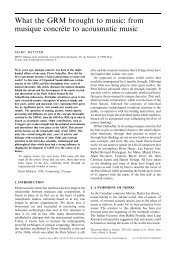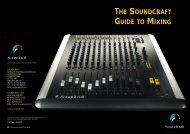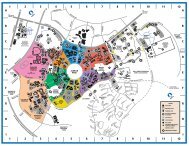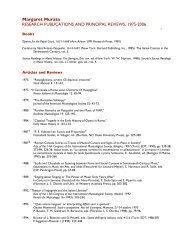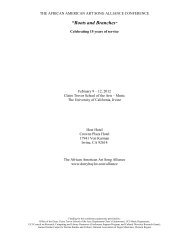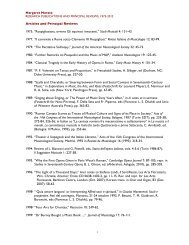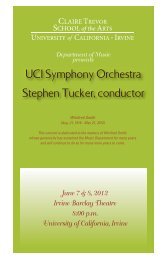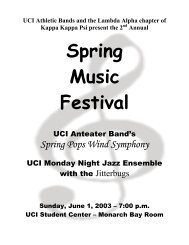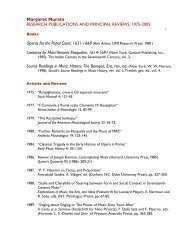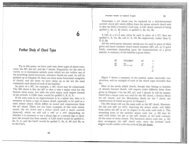3D motion capture data: motion analysis and mapping to music
3D motion capture data: motion analysis and mapping to music
3D motion capture data: motion analysis and mapping to music
Create successful ePaper yourself
Turn your PDF publications into a flip-book with our unique Google optimized e-Paper software.
4. MAPPING MUSIC TO GESTURE<br />
We developed a program <strong>to</strong> map aspects of <strong>motion</strong> <strong>to</strong> sound in<br />
the Max/MSP environment [13]. The program reads the <strong>motion</strong><br />
<strong>capture</strong> <strong>data</strong> <strong>and</strong> transforms it in<strong>to</strong> either MIDI parameters or<br />
parameters controlling signal processing. A video rendering of<br />
the animation can be played simultaneously <strong>to</strong> the <strong>music</strong><br />
generation. The <strong>mapping</strong> gesture-sound can be modified in<br />
real-time.<br />
Various <strong>mapping</strong>s, from triggering discrete <strong>music</strong>al events <strong>to</strong><br />
continuous control of sonic parameters, are currently the<br />
subject of experiments:<br />
1) Triggering. Sample sounds can be triggered based on events<br />
defined by the procedures described in sections 3.1 <strong>and</strong> 3.2.<br />
2) Sound synthesis <strong>and</strong> signal processing. In this case,<br />
continuous parameters are used <strong>to</strong> control for example the<br />
sound's timbre. These parameters can be the position, velocity<br />
or acceleration of any tracker, or the global parameters derived<br />
from the gesture <strong>analysis</strong> we described previously.<br />
5. CONCLUSIONS AND FUTURE<br />
WORK<br />
We have presented two methods of gesture <strong>analysis</strong>. The first<br />
one corresponds <strong>to</strong> segmenting a movement in several parts,<br />
while the second corresponds <strong>to</strong> gesture recognition.<br />
The experiments conducted with the first method of course<br />
deal with only a single marker in the <strong>motion</strong> <strong>capture</strong>. Although<br />
we feel that using all the points would be both overly complex<br />
<strong>and</strong> redundant, increasing the number of points analyzed could<br />
be very fruitful. Points on different parts of the body could be<br />
used <strong>to</strong> control separate processes, while a more complex<br />
translation <strong>to</strong> a <strong>music</strong>al process could be based segments from<br />
multiple points on the same body part. In the future we will<br />
also look at integrating the two methods of <strong>analysis</strong>.<br />
A crucial step in increasing the utility of these methods of<br />
course is <strong>to</strong> implement them with a real time <strong>motion</strong> <strong>capture</strong><br />
system. The expressiveness that can be found in this system<br />
can only be truly exploited if there is simultaneous feedback<br />
between the dancer <strong>and</strong> the <strong>music</strong>. In this way the dancer is<br />
not just a performer of dance <strong>and</strong> <strong>data</strong> source for the<br />
accompanying <strong>music</strong>, but becomes a performer <strong>and</strong> interpreter<br />
of both the dance <strong>and</strong> the <strong>music</strong>. We hope <strong>to</strong> achieve this in<br />
the new future by upgrading the current <strong>motion</strong> <strong>capture</strong> system<br />
used, <strong>and</strong>/or implementing the <strong>analysis</strong> on other systems.<br />
Video processing or machine vision systems are just two<br />
examples.<br />
6. ACKNOWLEDGMENTS<br />
We acknowledge the Claire Trevor School for the Art, <strong>and</strong> we<br />
particularly thank Prof. Lisa Naugle, direc<strong>to</strong>r of the Motion<br />
Capture facilities.<br />
We also thank Isabel Valverde, Alexia BonvinBevilacqua <strong>and</strong><br />
Chris<strong>to</strong>pher Dobrian.<br />
7. REFERENCES<br />
[1] F. Bevilacqua, L. Naugle <strong>and</strong> I. Valverde, “Virtual dance<br />
<strong>and</strong> <strong>music</strong> environment using <strong>motion</strong> <strong>capture</strong>” Proc. of the<br />
IEEE - Multimedia Technology And Applications<br />
Conference, Irvine CA, 2001<br />
[2] Part of this work will be used in an installation at the<br />
Museum of Pho<strong>to</strong>graphy-University of California<br />
Riverside, by Lisa Naugle, John Crawford, Frederic<br />
Bevilacqua, Isabel Valverde <strong>and</strong> Alexia<br />
BonvinBevilacqua.<br />
[3] "Trends in Gestural Control of Music", edited by: Marcelo<br />
W<strong>and</strong>erley <strong>and</strong> Marc Battier, Ircam - Centre Pompidou -<br />
2000.<br />
[4] J.A.Paradiso, "The Brain Opera Technology: New<br />
Instruments <strong>and</strong> Gestural Sensors for Musical Interaction<br />
<strong>and</strong> Performance", Journal of New Music Research<br />
Vol.28 No.2, pp.30-149, 1999.<br />
[5] A. Mulder, S. Fels <strong>and</strong> K. Mase . “Design of Virtual <strong>3D</strong><br />
Instruments for Musical Interaction”, Proceedings<br />
Graphics Interface '99, S. Mackenzie <strong>and</strong> J. Stewart Eds.,<br />
76-83, 1999.<br />
[6] J. Paradiso, "Electronic Music Interfaces: New Ways <strong>to</strong><br />
Play," IEEE Spectrum, 34(12), 18-30, 1997<br />
[7] A. Camurri, S. Hashimo<strong>to</strong>, M. Ricchetti, A. Ricci, K.<br />
Suzuki, R. Trocca, <strong>and</strong> G. Volpe "EyesWeb: Toward<br />
Gesture <strong>and</strong> Affect Recognition in Interactive Dance <strong>and</strong><br />
Music Systems", Computer Music Journal, Vol.24 No.1,<br />
pp. 57-69, 2000, or see http://musart.dist.unige.it/<br />
[8] F.Paracino, G.Davenport, <strong>and</strong> A.Pentl<strong>and</strong> "Media in<br />
performance: Interactive spaces for dance, theater, circus,<br />
<strong>and</strong> museum exhibits", IBM Systems Journal, Vol 39, No<br />
3&4, 2000.<br />
[9] Interactive Systems <strong>and</strong> Instrument, Design in Music<br />
Working Group,<br />
www.notam.uio.no/icma/interactivesystems/wg.html<br />
[10] Vicon, www.vicon.com.<br />
[11] Laplacian Edge Detection, Roger Claypoole, Jim Lewis,<br />
Srikrishna Bhashyam, <strong>and</strong> Kevin Kelly,<br />
www-ece.rice.edu/~kkelly/elec539/laplacian.html<br />
[12] M. Turk, “A r<strong>and</strong>om walk through eigenspace,” IEICE<br />
Trans Information <strong>and</strong> Systems, Vol.E84-D, No.12,<br />
pp.1586-1595, 2001.<br />
[13] Max/MSP, www.cycling74.com.<br />
.



